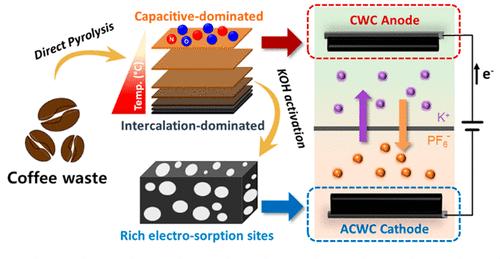当前位置:
X-MOL 学术
›
Energy Fuels
›
论文详情
Our official English website, www.x-mol.net, welcomes your feedback! (Note: you will need to create a separate account there.)
Direct Microstructure Tailoring of Hard Carbon Electrodes for Fabrication of Dual-Carbon Potassium-Ion Hybrid Supercapacitors
Energy & Fuels ( IF 5.3 ) Pub Date : 2024-04-18 , DOI: 10.1021/acs.energyfuels.3c04617 Kangseok Kim 1 , Jongyoon Park 1 , Jiyun Lee 1 , Eunho Lim 2 , Jongkook Hwang 1, 3
Energy & Fuels ( IF 5.3 ) Pub Date : 2024-04-18 , DOI: 10.1021/acs.energyfuels.3c04617 Kangseok Kim 1 , Jongyoon Park 1 , Jiyun Lee 1 , Eunho Lim 2 , Jongkook Hwang 1, 3
Affiliation

|
The microstructure of hard carbon, including interlayer spacing, the degree of graphitization, and doped heteroatoms, has a significant impact on the K+ storage capability of hard carbon anodes in potassium-ion hybrid supercapacitors (PIHCs). However, previously reported microstructural engineering methods typically involve complex, time-consuming, and expensive multistep processes. Herein, we report the simple pyrolysis-guided microstructural engineering of hard carbon materials using cost-effective coffee waste (CW) as a recycled single carbon source for the fabrication of PIHC devices. For battery-type anodes, the direct pyrolysis of CW at various temperatures (700, 900, and 1100 °C) is conducted to control the microstructures and K+ storage behavior of hard carbon anode materials. Carbon prepared at 700 °C exhibits high specific capacity, large capacitive K+ storage contribution, and rapid K+ storage kinetics as a result of abundant surface defects and functional groups as well as a wide interlayer spacing. For capacitor-type cathodes, high surface area activated carbon is prepared using an industrially available KOH activation method. The optimized PIHC full cell exhibits a high energy density of 120 Wh kg–1, a power density of 3378 W kg–1, and a capacity retention of 83.6% after 3000 cycles at 0.5 A g–1, comparable to carbon materials synthesized by complex multistep processes. These findings indicate that simple microstructural engineering via pyrolysis is sufficient for fabricating dual-carbon PIHCs with an adequate electrochemical performance.
中文翻译:

用于制造双碳钾离子混合超级电容器的硬碳电极的直接微观结构定制
硬碳的微观结构,包括层间距、石墨化程度和掺杂杂原子,对钾离子混合超级电容器(PIHC)中硬碳阳极的K +存储能力具有显着影响。然而,先前报道的微观结构工程方法通常涉及复杂、耗时且昂贵的多步骤过程。在此,我们报告了使用具有成本效益的咖啡废物(CW)作为制造 PIHC 设备的回收单一碳源的硬碳材料的简单热解引导微结构工程。对于电池型负极,在不同温度(700、900和1100℃)下直接热解CW来控制硬碳负极材料的微观结构和K +储存行为。由于丰富的表面缺陷和官能团以及较宽的层间距,在 700 °C 下制备的碳表现出高比容量、大电容 K +存储贡献和快速的 K +存储动力学。对于电容器型阴极,使用工业上可用的 KOH 活化方法制备高表面积活性炭。优化后的PIHC全电池表现出120 Wh kg –1的高能量密度、3378 W kg –1的功率密度,在0.5 A g –1下循环3000次后容量保持率为83.6% ,与通过合成碳材料合成的碳材料相当。复杂的多步骤过程。这些发现表明,通过热解进行的简单微观结构工程足以制造具有足够电化学性能的双碳 PIHC。
更新日期:2024-04-18
中文翻译:

用于制造双碳钾离子混合超级电容器的硬碳电极的直接微观结构定制
硬碳的微观结构,包括层间距、石墨化程度和掺杂杂原子,对钾离子混合超级电容器(PIHC)中硬碳阳极的K +存储能力具有显着影响。然而,先前报道的微观结构工程方法通常涉及复杂、耗时且昂贵的多步骤过程。在此,我们报告了使用具有成本效益的咖啡废物(CW)作为制造 PIHC 设备的回收单一碳源的硬碳材料的简单热解引导微结构工程。对于电池型负极,在不同温度(700、900和1100℃)下直接热解CW来控制硬碳负极材料的微观结构和K +储存行为。由于丰富的表面缺陷和官能团以及较宽的层间距,在 700 °C 下制备的碳表现出高比容量、大电容 K +存储贡献和快速的 K +存储动力学。对于电容器型阴极,使用工业上可用的 KOH 活化方法制备高表面积活性炭。优化后的PIHC全电池表现出120 Wh kg –1的高能量密度、3378 W kg –1的功率密度,在0.5 A g –1下循环3000次后容量保持率为83.6% ,与通过合成碳材料合成的碳材料相当。复杂的多步骤过程。这些发现表明,通过热解进行的简单微观结构工程足以制造具有足够电化学性能的双碳 PIHC。



























 京公网安备 11010802027423号
京公网安备 11010802027423号